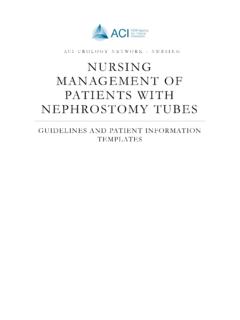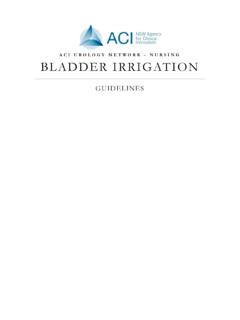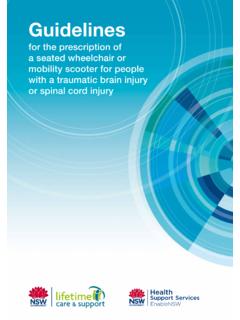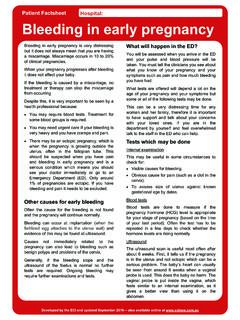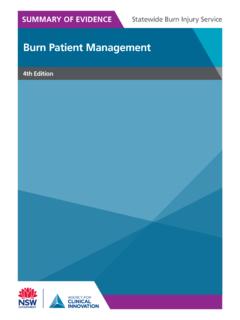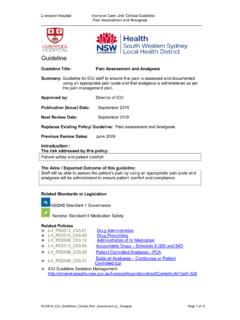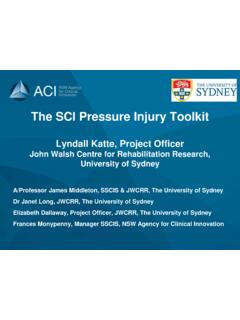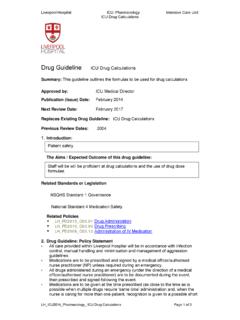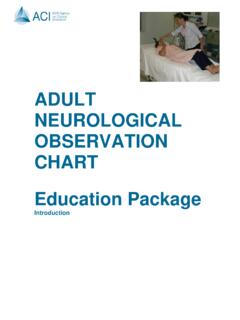Transcription of Non-invasive Ventilation Guidelines for Adult Patients ...
1 Non-invasive Ventilation Guidelines for Adult Patients with Acute Respiratory Failure Guideline provenance Full title Non-invasive Ventilation Guidelines for Adult Patients with Acute Respiratory Failure [SHPN. (ACI) 140008]. Guideline Owner Agency for Clinical Innovation ISBN 978-1-74187-954-4. Executive authorisation Dr Nigel Lyons, CE ACI. Writing team David Sanchez (Guideline Chair) Kaye Rolls Dr Gilly Smith Dr Amanda Piper Guideline development Cecily Barrack, Karen Chronister (Co-chair Evidence), Mary Dunford, Karla Lopez, Philip network members Marshall, Karlee McCann, Wanda McDermott, Simone Moran, Darrin Penola, Patrick Reagan, Sharon-Ann Shunker (Co-chair Practice), Richard Walker, Natalie Wright ICCMU Director Dr Sean Kelly Project Manager Kaye Rolls, RN ACC BAppSc(Syd) ICCMU & ACI.
2 Project Officer Janet Masters, RN Crit Care Cert BHSc(Nur) MN ICCMU & NaMO. Version number Year published/implementation 2014. Year for review 2017. Funding ACI-ICCMU is the primary project funder NaMO provided funding the Project Officer's salary Baxter Healthcare provided an unconditional education grant which was used to fund the 2012 project startup meeting. Baxter took no part in evidence review, recommendation development or guideline writing. Declaration of interest None declared Related NSW Health policies Infection Control Policy (PD2007_036). and Guidelines Hand Hygiene Policy (PD2010_058). Infection Control Policy: Prevention & Management of Multi-Resistant Organisms (PD2007_084). NSW Work Health & Safety Act (2011). Disclaimer This clinical practice guideline (CPG) is aimed at providing the clinicians working in NSW hospitals' intensive care units (ICU) with recommendations to frame the development of policies and procedures related to the provision of Non-invasive Ventilation for critically ill Adult Patients in acute care facilities.
3 This CPG is not intended to replace the critical evaluation processes that underpin the development of local policy and procedure nor does it replace a clinician's judgment in an individual case. Users of this CPG must critically evaluate this CPG as it relates to local circumstances and any changes in the literature that may have occurred since the dates of the literature review conducted. In addition, NSW Health clinicians must review NSW State Government policy documents to identify any directives that may relate to this clinical practice. These Guidelines are intended for use in NSW acute care facilities. These Guidelines are intended for use in adults only. Content within this publication was accurate at the time of publication. This work is copyright.
4 It may be reproduced in whole or part for study or training purposes subject to the inclusion of an acknowledgment of the source. It may not be reproduced for commercial usage or sale. Reproduction for purposes other than those indicated above, requires written permission from the Agency for Clinical Innovation. Suggested citation: Sanchez D, Smith G, Piper A and Rolls K (2014) Non invasive Ventilation Guidelines for Adult Patients with Acute Respiratory Failure: a clinical practice guideline. Agency for Clinical Innovation NSW government Version 1, Chatswood NSW, ISBN 978-1-74187-954-4. AGENCY FOR CLINICAL INNOVATION Agency for Clinical Innovation Level 4, Sage Building PO Box 699 Chatswood NSW 2057. 67 Albert Avenue, Chatswood NSW 2067 T +61 2 9464 4666 | F +61 2 9464 4728.
5 E | Further copies of this publication can be obtained from the Agency for Clinical Innovation website at: Disclaimer: Content within this publication was accurate at the time of publication. This work is copyright. It may be reproduced in whole or part for study or training purposes subject to the inclusion of an acknowledgment of the source. It may not be reproduced for commercial usage or sale. Reproduction for purposes other than those indicated above, requires written permission from the Agency for Clinical Innovation. Agency for Clinical Innovation 2014. i Non-invasive Ventilation Guidelines for Adult Patients with Acute Respiratory Failure 2014. FOREWORD. Over the past three decades Non-invasive Ventilation has emerged as a core therapy in the management of Patients with acute and chronic respiratory failure.
6 Adult Patients receiving Non-invasive Ventilation require complex care involving clinicians across healthcare specialties, highlighting the need for good communication, coordination and teamwork. The purpose of this guideline is to provide intensive care clinicians with best practice recommendations and guidance about how to best deliver Non-invasive Ventilation to Patients who need this sometimes life saving technology. Developed under the auspices of the Intensive Care Best Practice Manual Project, this guideline highlights the ability of the Agency for Clinical Innovation (ACI) to facilitate strong working relationships with clinicians as well other executive branches of the Ministry. On behalf of the ACI, I would like to thank Susan Pearce, Chief Nursing and Midwifery Officer for providing state executive sponsorship for the project and funds for the Project Officer.
7 I would also like to extend my appreciation to the LHD executives for facilitating the participation of LHD staff in developing these Guidelines , which I commend to you the clinicians of NSW. Dr Nigel Lyons Chief Executive, Agency for Clinical Innovation ABOUT THE ACI. The Agency for Clinical Innovation (ACI) works with clinicians, consumers and managers to design and promote better healthcare for NSW. It does this by: Service redesign and evaluation applying redesign methodology to assist healthcare providers and consumers to review and improve the quality, effectiveness and efficiency of services. Specialist advice on healthcare innovation advising on the development, evaluation and adoption of healthcare innovations from optimal use through to disinvestment.
8 Initiatives including Guidelines and Models of Care developing a range of evidence-based healthcare improvement initiatives to benefit the NSW health system. Implementation support working with ACI Networks, consumers and healthcare providers to assist delivery of healthcare innovations into practice across metropolitan and rural NSW. Knowledge sharing partnering with healthcare providers to support collaboration, learning capability and knowledge sharing on healthcare innovation and improvement. Continuous capability building working with healthcare providers to build capability in redesign, project management and change management through the Centre for Healthcare Redesign. ACI Clinical Networks, Taskforces and Institutes provide a unique forum for people to collaborate across clinical specialties and regional and service boundaries to develop successful healthcare innovations.
9 A priority for the ACI is identifying unwarranted variation in clinical practice and working in partnership with healthcare providers to develop mechanisms to improve clinical practice and patient care. ii Non-invasive Ventilation Guidelines for Adult Patients with Acute Respiratory Failure 2014. Guideline development network members GUIDELINE MANAGEMENT TEAM. Dr Gilly Smith RN, JP (Justice of the Peace), Bachelor of Senior Lecturer School of Nursing and Nursing (Honours), Grad Cert in Intensive Midwifery Edith Cowan University Care Nursing, Grad Cert in Cardio-thoracic Nursing, Grad Dip in Psychology Doctor of Business Administration David Sanchez RN, Dip of App Sc (Nur), Ba Health, IC Cert Clinical Nurse Consultant (Intensive Care), (NSW CON), Grad Dip Health Sc Ed (USyd) Campbelltown Hospital Karen Chronister RN, Dip App Sc (Nur), Dip (Government), Rural Critical Care Clinical Nurse Consultant Grad Cert (Intensive care) (ICU/HDU), HNE LHD.
10 Sharon-Anne Shunker RN, BHSc (Nur), Grad Cert in Intensive Care CNC Intensive Care Unit, Nursing, Masters in Public Health Liverpool Hospital Dr. Amanda Piper BAppSc (Phty), MEd, PhD Senior Physiotherapist, Royal Prince Alfred Hospital MEMBERS. Karla Lopez RN, BHSc (Nur), Crit Care Cert, Clinical CNE, Liverpool ICU. Education Cert, Masters of Health Sc Phillip Marshall RN, BNursing, Grad Cert Crit Care Nur - ICU Nurse Educator ICU, Sutherland Hospital Karlee McCann RN, BNursing, MHealth Sc, Clinical Practice St Vincent's Hospital ICU. (ICU). Wanda McDermott RN, Dip of Nursing (Community, Psychiatry Clinical Skills Educator, & Midwifery), Grad Cert (Crit Care), BN Prof Sydney Adventist Hospital Clinical School Honours (Clinical Nursing and Teaching). Simone Moran RN, BNursing, GradCert (Critical Care) St George Hospital ICU.
